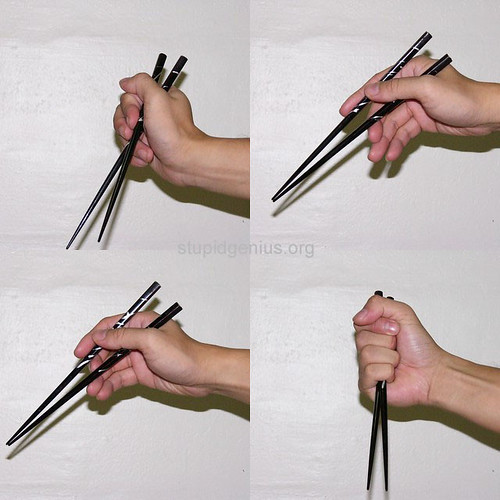
The topic of methods of using the chopsticks has always crept into conversations with friends. How do you use the chopsticks "correctly", if there is indeed a correct method. I would say whichever method suits you, and you think you are happy with it, then it's good enough. But, I also believe there's a traditional method, and that method is the most efficient way of using chopsticks.
From what I observed, there are 4 ways of using the chopsticks to pick items. Three's a 5th method for eating rice from a bowl, which I will not cover here. Basically, that method is to hold the chopsticks together, bring the bowl to your mouth, and push the rice into your mouth using the chopsticks.
I present to you, my comparison of the different methods. I do not profess to be an expert in using chopsticks, nor am I an evangelist for my preferred way of using chopsticks. Whichever method you prefer, or you think is better is entirely up to you.
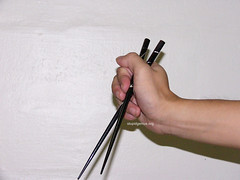 The first method, and likely the most common method, I call it the cross method. you hold the chopsticks using your thumb, index finger and middle finger. The chopsticks will form a cross at about the place where you are holding it. This is the easiest method, and likely to be the method you'll use if you have never use chopsticks before. It was the method I used long long time ago. The first method, and likely the most common method, I call it the cross method. you hold the chopsticks using your thumb, index finger and middle finger. The chopsticks will form a cross at about the place where you are holding it. This is the easiest method, and likely to be the method you'll use if you have never use chopsticks before. It was the method I used long long time ago. |
|
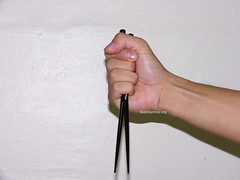 This method is mostly used to complement the cross method. At times when the object to be picked is too slippery, and if it is soft enough, you can grab the chopsticks together and poke it through the object, just like you would use a toothpick. An example is the fish ball. This method is mostly used to complement the cross method. At times when the object to be picked is too slippery, and if it is soft enough, you can grab the chopsticks together and poke it through the object, just like you would use a toothpick. An example is the fish ball.
There are limited objects where u can poke your chopsticks through, but I've also seen people who managed to use the grab method like a cross method to pick up objects. This way, you do not have to switch methods, but it looks quite difficult and requires a lot of practice. |
|
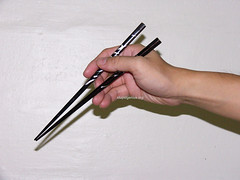 This method is the traditional method. In my opinion, this is the most efficient way of using the chopsticks. It allows you to hold heavy objects firmly, and yet at the same time be able to handle delicate objects. This method is the traditional method. In my opinion, this is the most efficient way of using the chopsticks. It allows you to hold heavy objects firmly, and yet at the same time be able to handle delicate objects.
This is the method I am using now. It is the most difficult method. It requires a lot of practice and cramped thumbs. At least for me, it is. |
|
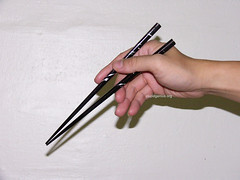 I would say this is a variation of the traditional method, but in actual fact, I am not exactly sure which is the original traditional method. Maybe they both are. I would say this is a variation of the traditional method, but in actual fact, I am not exactly sure which is the original traditional method. Maybe they both are.
They both look very similar, with 1 difference, the role of the middle finger. In the 1st traditional method, the middle finger is used to control the chop chopstick, while the 2nd method is used to support the bottom chopstick.
This method uses 1 less finger to control the top chopsticks, which is the main player here. And therein lies it's weakness, it's more difficult to control the chopstick. |
After looking at the 4 methods, you may realize that although there are 4 methods, there's only 2 main principle of picking up objects. The 1st 2 methods uses the cross principle, while the next 2 methods uses the point principle. I will attempt to explain what exactly is these 2 principles.
Cross principle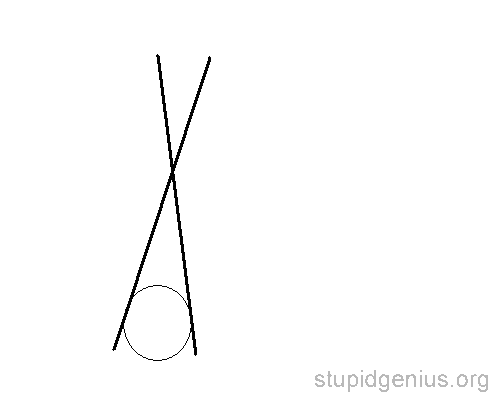
I think another name for this principle can be the fulcrum principle. The chopsticks intersected each other somewhere near the top part of the chopstick. Using the intersect point as the pivot to pick the items using the bottom part of the chopstick. Looking at the diagram above, you'll see that if the object is slippery, it is likely to slip down. This is where the grab/poke method will complement. If it still fails, there's always the spoon.
Point principle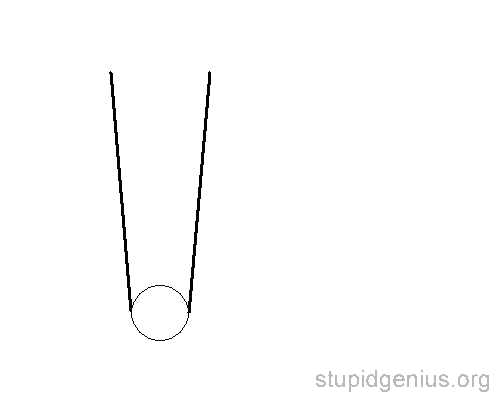
This principle uses the bottom tip of the chopsticks to pick up the object, much like how you would do using your fingers. I thought this method is more stable and items held in the chopsticks are less likely to slip/fall out.
So how do you execute the traditional method way of using chopsticks? First, you hold 1 chopstick somewhere near the top in the valley between your thumb and index finger. First, you hold 1 chopstick somewhere near the top in the valley between your thumb and index finger. |
|
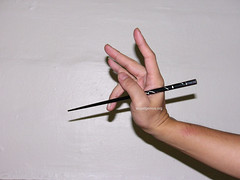 Next twist ur hand abit such tat each side of the valley form a 2 point contact with the chopstick. Then, bring your third finger, the one beside the pinky finger, to the chopstick somewhere further down. Note that there is now a 3 point contact between hour hand and the chopstick. The side of the bottom below the index finger, the bottom of the thumb and the forth finger. Next twist ur hand abit such tat each side of the valley form a 2 point contact with the chopstick. Then, bring your third finger, the one beside the pinky finger, to the chopstick somewhere further down. Note that there is now a 3 point contact between hour hand and the chopstick. The side of the bottom below the index finger, the bottom of the thumb and the forth finger. |
|
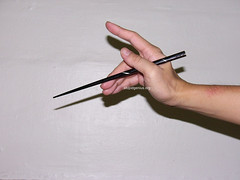 You can use the middle finger instead if you wanted to use the variation. You can use the middle finger instead if you wanted to use the variation.
Which ever variation you use, this first chopstick is fixed firmly in the 3 point contact and it should not move. Only the other chopstick is moving when you are trying to pick something. |
|
 Hold the other chopstick using the tip of your thumb and the 1st joint of your index finger at about the same spot where the 1st chopstick is resting in the valley between your thumb and index finer. Bring the tip of both your index finger and your middle finger to the chopstick. Hold the other chopstick using the tip of your thumb and the 1st joint of your index finger at about the same spot where the 1st chopstick is resting in the valley between your thumb and index finer. Bring the tip of both your index finger and your middle finger to the chopstick.
The tip of the chopsticks must be touching each other when in rest position, forming a V. This will enable you to pick up light objects using much strength, and light objects are what you will be picking with your chopsticks most of the time.
To pick something up, move the tips away from each other by moving your middle finger up, this will swing the chopstick up, pivoting at the point where your thumb is holding it at the 1st joint of the index finger. Bring your chopsticks to the object, such that the chopsticks are on each side of the object, with the fixed chopstick lightly touching the object. Close it by moving your index finger down, which will swing the chopstick back down. With the fixed chopsick remaining still, and the moving chopstick pushing the object against it, you should be able to form a grip on the object.
You'll need lots of practice on this. |
|
 If you are using the variation method, your middle finger is already supporting 1st chopstick, thus only the index finger and the thumb is used to control the top chopstick. If you are using the variation method, your middle finger is already supporting 1st chopstick, thus only the index finger and the thumb is used to control the top chopstick. |
I hope the above information is useful to you. As with most things, practice makes perfect, so don't forget to try using it at every opportunity.
More information about chopsticks:
Kitchenware.orgWikipedia

















Subscribe to Post Comments [Atom]
i personally think the traditional method looks better and more graceful than the first method...
I agree! I was using the cris cross method when I started using chopsticks and finally learnt how to hold them properly from my mum.
holding them the traditional way do look more graceful.
i dunno, since young my family is fork n spoon..mum didnt really correct me...i'm using the erm..dunno wat method.. so long as u can get the food up
wow.... this is the lamest post i've read all year. geez, some people really have no life
what next? difference between using the porcelain chinese spoon and western metal soup spoon to drink kambing soup>?
I dunno what method am I using, but I tried using the traditional method and I couldn't really pick anything up, in the end, I gave up. Haha... I guess it's more like a habit so use to since young.
rani & inex> yep yep. It's easier to use once you mastered it too.
jkaiser> yeah. as long as the food gets into the mouth.
anno> haha! yeah. i was feeling bored.
darkharf> It does need some practice. but once u mastered it, it shld be easier to pick up things.
what next? difference between using the porcelain chinese spoon and western metal soup spoon to drink kambing soup>?
Anyone can tell you that the porcelain spoon is more effective at delivering amounts of soup in equal proportions to all areas of your tongue, thus having the most satisfactory effect. So don't laugh.
i sux! the last finger muscle always aches like crazy. just can't do it ...ur instructions not clear enuff for me.
the 3 points touch for the 'fixed' chopstick ..only 2 points what. the valley between thumb and forefinger ...and the last finger and/or 2nd last finger mah???
another hard part is the movable chopstick using forefinger, middle finger and tip of thumb ....when closing both chopstick, 'no' strength to pick things at all...
HELPPPPPPP
anon> erm... I gotta ask u a stupid qn. are u being serious or sarcastic?
freakkler> It's 3 point. 1st you place it in the value, then u twist ur hand abit such tat each side of the valley forms 2 points. The last point is the 4th finger.
Grip the moveable chopstick btwn ur thumb and the 1st joint of ur forefinger. then use the tip of your forefiner and middlefinger to pivot it around the poitn where ur thumb is holding it.
It's common to feel aches at your thumb when it trying to grip the 2 chopsticks. will get better after you are used to it.
buay sai leh :( *exasperated*
oh well, i know you are going to say it's all about practice.
but technique wise, i still 1 more question --- 3rd finger between small and middle do what???
i observe my uncontrollable movements got 2 types, one is to support the fixed chopstick, the other is to 'hang limply' but got to focus mind to result in the 'do-nothing' state leh. how pls?
thanks hor
Oh. Apologies, so the finger beside the small finger is called the 3rd finger, I thought it's the 4th.
The 3rd finger is used to support the fixed chopstick. The small finger will hang there limply.
The fixed chopstick is to remain solidly still so that the other chopstick can move against it when picking things up.
Remeber that the initial position of the chopsticks are the tips touching, forming a V. Then you swing out the moving chopstick so that they are about parallel to each other, then place your chopsticks such that they are on 2 sides of the object you want to pick up, and close down by swinging back moving chopstick. With the fixed chopsick remaining still, and the moving chopstick pushing the object against it, you should be able to form a grip on the object.
this is a REAL nasty battle ... tried out at dinner outside tonite. terrible excruciating sight to behold. but no use lah, after 5mins, the Cross-method outlast the 'proper' method. coz it was just taking too long, and although form-wise, looks good, ...but when time for action calls ....at the key moment of 'kiap' food ---> sure went into cross-mode to pick it up...n i think the technical point is ...the 'fixed' chopstick somehow will slipped from the valley and slide towards my forefinger (at the point of my forefinger knucle) ...so this was possible the direct cause of the failure.
wow~ i re-read above, sounds like a very prim and proper technical report submission to you leh. ..paiseh.
oh well, ...just feedback to u lor. will try again next time ...=P
Bye for now ..and so long.
you have to grip it tightly btwn ur 3 point contact.
it took me one night back in 1988 to learn the traditional method. i was 15 then. a school mate has told me about the correct usage.
one day, i was "keeping the night" at my grandfather's funeral wake, and was alone sitting next to his coffin. with nothing to do, i decided to practise this.
this method definitely served me well for the last 18 years.
I use the skew line method.
I find this method more intuitive than the traditional method, and I am able to have a very firm grip on the food. I am also able to get fishballs and such without resorting to the poke method. I doubt that the traditional method can have as firm a grip as the skew line method(thumb, index and middle finger all work closely together), since you are not able to use brute force with it(you have to use close to the tip of your index finger, thus principle of moments means less force is produced at the food). The only advantage of the traditional method over the skew line method is that it can grab smooth objects which are so delicate that a firm grip will crush them(think of the cross between agar agar and chawanmushi, I don't know which food fits the description). The redeeming feature of the traditional method is it's aesthetic appeal.
bliz: Good for you. Sadly, I am not aware of the skew line method. From your description, it sounds like the tradditional method. You need the thumb, index and middle finger to work together for the tradditional method. You do not need any force to pick most things. Force is needed only when you are picking up heavy or bulky objects.
Anyway I have friends who are using the cross method so well that they have no problems picking up heavy and bulky objects.
As conclusion, from your descriptions, it seems that the only advantage your skew line method have over the tradditional is that it's more intuitive to use. There's 2 disadvantages. It can't pick up items that are too soft as it will crush them and that it does not look as nice aesthetically.
Post a Comment
<< Home